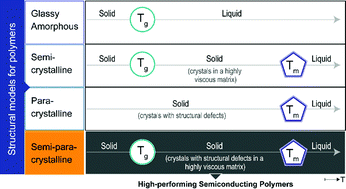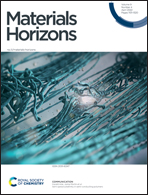Semi-paracrystallinity in semi-conducting polymers†
Abstract
Precise determination of structural organization of semi-conducting polymers is of paramount importance for the further development of these materials in organic electronic technologies. Yet, prior characterization of some of the best-performing materials for transistor and photovoltaic applications, which are based on polymers with rigid backbones, often resulted in conundrums in which X-ray scattering and microscopy yielded seemingly contradicting results. Here we solve the paradox by introducing a new structural model, i.e., semi-paracrystalline organization. The model establishes that the microstructure of these materials relies on a dense array of small paracrystalline domains embedded in a more disordered matrix. Thus, the overall structural order relies on two parameters: the novel concept of degree of paracrystallinity (i.e., paracrystalline volume/mass fraction, introduced here for the first time) and the lattice distortion parameter of paracrystalline domains (g-parameter from X-ray scattering). Structural parameters of the model are correlated with long-range charge carrier transport, revealing that charge transport in semi-paracrystalline materials is particularly sensitive to the interconnection of paracrystalline domains.

- This article is part of the themed collections: 2022 Horizons Outstanding Paper Award Winners and Materials Horizons 2022 Most Popular Articles


 Please wait while we load your content...
Please wait while we load your content...